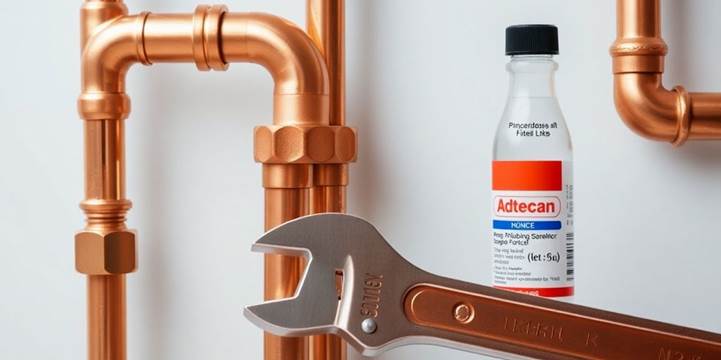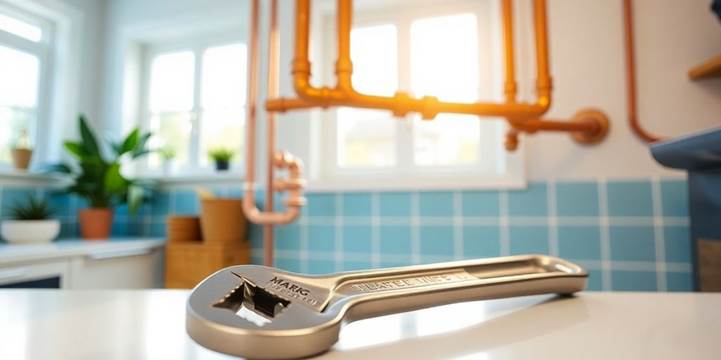Spring is the perfect time to give your home’s plumbing a good once-over. After a long winter, it’s wise to check for any issues that might have popped up. A little attention now can save you from bigger headaches later.
- Inspect Faucets and Fixtures for Leaks
- Evaluate Outdoor Plumbing Components
- Examine Your Water Heater’s Condition
- Clear Out Clogged Drains
- Summer Plumbing Preparedness
- Check for Toilet Leaks
- Inspect Washing Machine Hoses
- Maintain Your Water Heater Efficiency
- Conserve Water with Fixture Upgrades
- Fall Plumbing Preparations
- Insulate Exposed Pipes
- Prepare Outdoor Faucets and Hoses
- Inspect Your Sewer System
- Clean Your Garbage Disposal
- Winter Plumbing Protection
- Year-Round Plumbing Vigilance
- Conduct Monthly Visual Inspections
- Test Your Water Pressure Regularly
- Clean Faucet Aerators and Showerheads
- Keep Drains Clear with Natural Flushes
- Essential Plumbing Maintenance Practices
- Know Your Main Water Shutoff Valve Location
- Be Mindful of What Goes Down the Drain
- Seal Grout and Caulk Around Fixtures
- Schedule Annual Plumbing Checkups
- Keeping Your Plumbing in Good Shape
Inspect Faucets and Fixtures for Leaks
Leaky faucets are more than just annoying; they waste water and money. Check every faucet and showerhead in your house. Look for drips, even small ones, and feel around the base for any moisture. Fixing these small leaks promptly is key to preventing water damage and keeping utility bills down. This simple inspection is a vital part of your spring plumbing tune-up.
Evaluate Outdoor Plumbing Components
Don’t forget about the plumbing outside your home. Winter’s freeze-thaw cycles can be tough on outdoor faucets, also known as hose bibs. Inspect them for cracks or leaks. Also, check any sprinkler systems or outdoor spigots to make sure they’re in good shape and ready for the warmer months. Proper care of your outdoor plumbing prevents costly repairs.
Examine Your Water Heater’s Condition
Your water heater likely worked hard all winter. Now’s the time to check its condition. Look for any signs of rust or leaks around the tank or connections. It’s also a good idea to check the temperature setting; around 120°F is usually recommended for efficiency and safety. A well-maintained water heater is a cornerstone of your home’s plumbing system.
Clear Out Clogged Drains
As you start spring cleaning, tackle those slow or clogged drains. Pouring boiling water down drains can help loosen minor buildup. For tougher clogs, a mixture of baking soda and vinegar can be effective. Remember, avoiding putting grease or harsh chemicals down your drains is the best way to keep them clear. Regular drain maintenance is a simple yet effective part of your spring plumbing tune-up.
Summer Plumbing Preparedness
Summer often means more activity around the house, and with that comes increased use of your plumbing system. It’s a good time to check in on a few key areas to prevent unexpected problems. Keeping up with these checks can save you from costly repairs down the line and ensure your home’s plumbing runs smoothly during the warmer months.
Check for Toilet Leaks
Toilets can be sneaky water wasters. A small leak in the tank can add up quickly. A simple test involves adding a few drops of food coloring to your toilet tank. Wait about 30 minutes without flushing. If you see color in the toilet bowl, it means the tank is leaking and needs attention. Addressing toilet leaks is a straightforward way to conserve water and lower your utility bills.
Inspect Washing Machine Hoses
With more people at home or on vacation, laundry cycles might increase. Washing machine hoses, especially older rubber ones, can degrade over time. Look for any signs of bulging, cracking, or leaks. It’s wise to replace these hoses every three to five years, even if they appear to be in good condition, as a preventative measure. A burst hose can cause significant water damage.
Maintain Your Water Heater Efficiency
Your water heater has likely been working hard. Flushing the tank can remove sediment that builds up, which can make the heater less efficient and shorten its lifespan. Also, check the temperature setting. Setting it around 120°F is usually sufficient for most households, saving energy and reducing the risk of scalding.
Conserve Water with Fixture Upgrades
Summer often brings higher water usage. Consider upgrading older fixtures to low-flow models. These fixtures use less water without sacrificing performance. Installing aerators on faucets and showerheads can also make a difference. These small changes contribute to overall water conservation efforts throughout your home.
Fall Plumbing Preparations
As the leaves turn and the air gets crisp, it’s time to shift focus to your home’s plumbing. Fall is a prime season for getting ahead of winter’s challenges and keeping everything running smoothly. For expert seasonal maintenance and tips, you can also check out their website at T.Webber. Taking a little time now can save you a lot of headaches and costly repairs down the road.
Insulate Exposed Pipes
Cold weather can wreak havoc on unprotected pipes. Areas in your basement, crawl spaces, or even unheated garages are particularly vulnerable. Wrapping exposed pipes with foam insulation sleeves or specialized pipe wrap is a simple yet effective way to prevent them from freezing and bursting. This preventative measure is quite affordable and can prevent significant damage. Don’t forget to check any pipes that run along exterior walls.
Prepare Outdoor Faucets and Hoses
Before the first hard freeze, it’s important to winterize your outdoor plumbing. This means disconnecting and draining all garden hoses. Then, shut off the water supply to your outdoor faucets, often called hose bibs. Leaving water in these lines can lead to freezing, expansion, and ultimately, burst pipes. If you have frost-free hose bibs, ensure they are functioning correctly after draining.
Inspect Your Sewer System
Fall is a good time to think about your sewer system. Heavy rains and melting snow in the spring can put a strain on it. Consider having your sewer lines inspected and cleaned by a professional. This can help prevent blockages and backups, especially as you head into the holiday season when kitchen usage often increases. A clean sewer system is key to avoiding messy problems.
Clean Your Garbage Disposal
With holiday cooking just around the corner, giving your garbage disposal a good cleaning is a smart move. Run a few ice cubes through it to help dislodge any gunk. Follow that up with some citrus peels, like lemon or orange, to freshen it up. A clean disposal works more efficiently and is less likely to cause clogs later on. Remember, it’s best to avoid putting fibrous materials or grease down the disposal.
Winter Plumbing Protection
Winter can be harsh on your home’s plumbing. Taking proactive steps can save you from costly repairs and inconvenient water shutoffs. Protecting your pipes from freezing is the top priority during the colder months.
Prevent Frozen Pipes
When temperatures drop significantly, pipes are at risk. Keep cabinet doors under sinks open to allow warmer air to circulate around pipes, especially those on exterior walls. For extreme cold snaps, letting a faucet drip slowly can prevent water from freezing inside the pipes. This simple act of letting water drip can make a big difference in preventing frozen pipes.
Insulate Vulnerable Pipes
Areas like basements, crawl spaces, and garages often house pipes that are more exposed to the cold. Use foam insulation sleeves or pipe wrap to add a protective layer. This is a straightforward and affordable way to guard against freezing. Properly insulating vulnerable pipes is a key part of winter plumbing protection.
Monitor Water Pressure
A noticeable drop in water pressure might signal a problem, possibly a frozen pipe. If you experience this, it’s wise to check your pipes for any signs of ice buildup. If you suspect a frozen pipe, thaw it carefully. Keeping an eye on your water pressure is a good habit for winter vigilance.
Check for Frozen Pipes
Regularly inspect exposed pipes for any frost or ice. If you find frozen pipes, act quickly. You can try to thaw them gently with a hairdryer or warm cloths. Never use an open flame. Knowing how to check for frozen pipes can prevent a burst.
Preventing frozen pipes requires attention to detail and consistent effort throughout the winter season. Simple measures can avert major damage.
Year-Round Plumbing Vigilance
Keeping your home’s plumbing in good shape doesn’t just happen once a year. It’s about staying on top of things regularly. Think of it like giving your car an oil change; small, consistent actions prevent big, expensive problems down the road. This proactive approach to plumbing maintenance is key.
Conduct Monthly Visual Inspections
Make it a habit to walk around your home once a month and just look at your plumbing. Check exposed pipes in the basement or under sinks for any signs of moisture, rust, or drips. Give your faucets and showerheads a quick once-over to see if they’re leaking. Listen for any strange sounds like banging or hissing, which could signal an issue. Catching small problems early is the best way to avoid major headaches. This regular check-up is a simple yet effective part of year-round plumbing vigilance.
Test Your Water Pressure Regularly
Sudden changes in water pressure can be a clue that something’s up with your plumbing. If the pressure suddenly drops or spikes, it’s worth investigating. You can buy a simple water pressure gauge at most hardware stores to check it yourself. Ideally, your home’s water pressure should be between 40 and 60 PSI. If it’s consistently too high, it can strain your pipes and fixtures, leading to leaks or even bursts. Maintaining proper water pressure is a smart move for your plumbing system.
Clean Faucet Aerators and Showerheads
Over time, mineral deposits can build up in faucet aerators and showerheads, reducing water flow and pressure. This is a common issue that affects performance. To clean them, simply unscrew the aerator or showerhead and soak it in a bowl of white vinegar overnight. In the morning, scrub away any remaining deposits with an old toothbrush and reassemble. This simple cleaning task can make a noticeable difference in your water flow and is a great example of consistent plumbing care.
Keep Drains Clear with Natural Flushes
To prevent slow drains and minor clogs, try a natural flush once a month. Pouring a mixture of baking soda followed by white vinegar down your drains can help break down grease and grime. Let it sit for about 15-30 minutes, then flush with hot water. This method is gentler on your pipes than harsh chemical drain cleaners and contributes to keeping your drains clear as part of your year-round plumbing vigilance.
Essential Plumbing Maintenance Practices

Know Your Main Water Shutoff Valve Location
It’s really important to know where your main water shutoff valve is. This knowledge can save your home from serious water damage if a pipe bursts or a major leak happens. Make sure everyone in the household knows its location too. It’s usually found where the main water pipe enters your house, often in a basement, crawl space, or utility closet. Knowing how to turn off the water quickly is a key part of plumbing maintenance.
Be Mindful of What Goes Down the Drain
What you put down your drains matters a lot for keeping your plumbing working right. Things like grease, coffee grounds, and hair can build up and cause clogs. It’s better to throw grease in the trash instead of down the sink. Using drain strainers in sinks and tubs can catch debris before it causes problems. Remember, just because something can go down the drain doesn’t mean it should. Proper disposal habits are a simple yet effective way to prevent clogs and keep your plumbing system clear.
Seal Grout and Caulk Around Fixtures
Check the grout and caulk around your sinks, tubs, and showers regularly. If you see any cracks or gaps, reseal them. This stops water from seeping behind tiles and into walls or floors, which can lead to rot and mold. Good sealing around fixtures is a small step that prevents bigger water damage issues down the line. It’s a simple way to protect your home’s structure.
Schedule Annual Plumbing Checkups
Think of an annual plumbing checkup like a yearly physical for your home’s plumbing. A professional plumber can spot small problems before they become big, expensive ones. They can check your water heater, look for leaks you might not see, and make sure your water pressure is okay. Scheduling this regular maintenance is a smart move for keeping your plumbing system in good shape year after year. It’s a proactive approach to plumbing care.
Keeping Your Plumbing in Good Shape
So, taking care of your home’s pipes isn’t really a mystery. It’s mostly about paying attention and doing a few simple things regularly. Checking for leaks, keeping drains clear, and knowing when to call a pro can save a lot of hassle and money down the road. Think of it like changing the oil in your car; a little effort now means fewer big problems later. By following these tips, you’re helping your plumbing system work right all year long, which is pretty important for a comfortable home.













